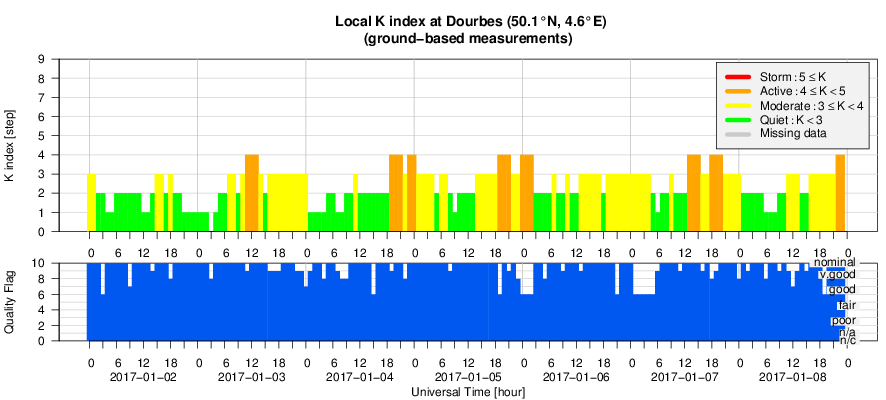- Table of Content
- 1.RoboSWOP in a ...
- 2.Call for contr...
- 3.PROBA2 Observa...
- 4.Review of sola...
- 5.The Internatio...
- 6.Review of geom...
- 7.Geomagnetic Ob...
- 8.Review of iono...
- 9.Future Events
2. Call for contributions on GNSS
3. PROBA2 Observations (2 Jan 2017 - 8 Jan 2017)
4. Review of solar activity
5. The International Sunspot Number
6. Review of geomagnetic activity
7. Geomagnetic Observations at Dourbes (2 Jan 2017 - 8 Jan 2017)
8. Review of ionospheric activity (2 Jan 2017 - 8 Jan 2017)
9. Future Events
RoboSWOP in a space game EUFHORIA looking for hidden sunspot treasures
What does this title means? Let us explain.
Different forms of energy move through space and plunge into the earth and its environment. This stream of energy can come from outer space, but it is mainly our Sun that drives it. Sudden and violent changes in this state of energy are referred as space weather. Often these storms originate in sunspots and clouds of suns material exploding in a violent way.
Because of its possible impact on earth, we are interested in keeping an eye on those sunspots and space weather clouds.
The sunspots, literally dark spots on the sun, have been counted and immortalised in paper drawings at the STCE for a long time. The drawings are acquired since March 1940 and the sunspot counts at kept in a digital database since 1981 resulting in a valuable heritage collections - truly treasures - but at the moment still hidden. And this is what we want to change: after the treasury has been smudged up, we will open up and share it with the science community and even broader.
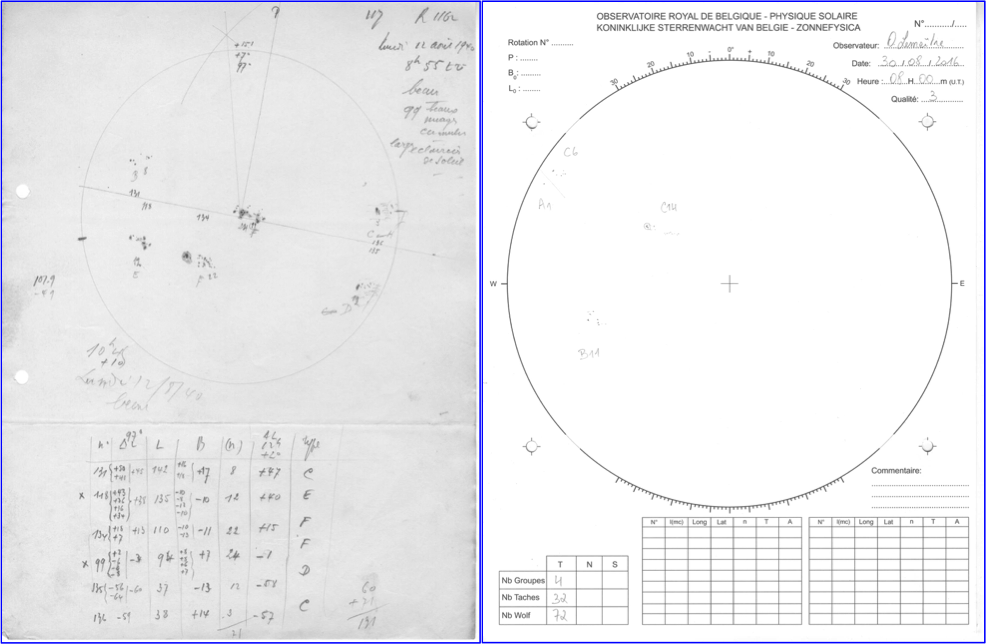
Two sunspot drawings made at the Royal Observatory of Belgium. This unexplored heritage collection spans more than 70 years of observations, with 23021 hand made drawings showing 87193 groups of sunspots.
We also keep track of solar clouds and try to forecast when a cloud will impact earth and how strong the impact will be. The forecaster identifies the cloud as complete as possible by checking other solar events and all sort of solar observations and solar images. The ‘Robotic Space Weather Operator’ or RoboSWOP will automate this part of the forecaster job. Automated software is not new, but what is innovating here is that we will make RoboSWOP think as a forecaster by mapping a forecasters mind and implementing it. And on top of this, RoboSWOP will be able to produce a 3D picture of these giant eruptions of energetic plasma. Sounds great, isn’t it!

3 views from a plasma cloud travelling through space. The small yellow ball is a real picture of the sun, similar as the grey area a real picture is of the surroundings of the sun.
We go even further in this forecasting process. We want to simulate the passage of the plasma cloud through space while it is heading towards earth. Just like in a video game, we create a space world EUFHORIA that resembles real space filled with invisible forces and where the cloud interact with its almost vacuum surroundings. A thoroughgoing understanding of space physics, damn good programmers and huge computers are the ingredients for this innovative forecasting tool. Real space weather forecast centres, like ours for example, will certainly benefit from it.
Recently, the STCE was informed that funding to make this all happen is on its way. A happy start for these three challenges!
Call for contributions on GNSS
Dear colleagues
in the last European Space Weather Week in Oostende we had an interesting session on “Space Weather Effects on GNSS and Precise Positioning” with several very good talks. In our session we had eight authors with oral and poster contributions willing to submit a paper to a special Issue on this subject. Unfortunately we missed the critical mass for such a topical issue.
However, the editors of the Journal of Space Weather Space Climate (SWSC) suggested to initiate a topical issue for “Space Weather Effects on GNSS and Precise Positioning” in 2017, which is also open to papers that were not presented at the ESWW.
Therefore, if you like to contribute to a special issue on “Space Weather Effects on GNSS and Precise Positioning “ with your own work, please write a short mail to jens.berdermann@dlr.de with your name, the title and if possible with a short abstract of your paper.
As soon as we get feedback from enough authors we will initiate the process together with the SWSC editors and inform all interested authors about the next steps.
The open access Journal of SWSC has an impact factor of 2.846. There will be a review process for all contributions. The journal asks an article processing charge for accepted publication of 800€+tax
With kind regards
Jens Berdermann and Claudia Borries
Chair of the ESWW session “Space Weather Effects on GNSS and Precise Positioning” , http://www.stce.be/esww13/program/session_details.php?nr=6
PROBA2 Observations (2 Jan 2017 - 8 Jan 2017)
Solar Activity
Solar flare activity was very low during the week.
In order to view the activity of this week in more detail, we suggest to go to the following website from which all the daily (normal and difference) movies can be accessed: http://proba2.oma.be/ssa
This page also lists the recorded flaring events.
A weekly overview movie can be found here (SWAP week 354)
http://proba2.oma.be/swap/data/mpg/movies/weekly_movies/weekly_movie_2017_01_02.mp4.
Details about some of this week’s events, can be found further below.
If any of the linked movies are unavailable they can be found in the P2SC movie repository here
http://proba2.oma.be/swap/data/mpg/movies/overview.php
Wednesday Jan 04
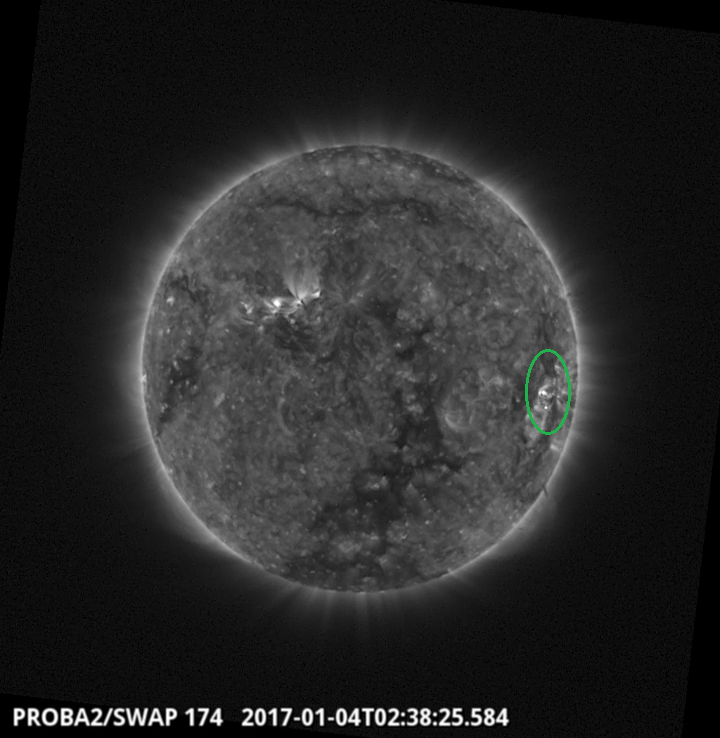
An eruption was observed by SWAP near the West limb of the Sun at 02:39 UT on January 4th.
Find a movie of the event here (SWAP movie)
http://proba2.oma.be/swap/data/mpg/movies/20170104_swap_movie.mp4
Friday Jan 06

A coronal hole stretching from the northern hemisphere to south pole
has dominated the solar disk since Jan 02. This is clearly seen on 2017-Jan-06.
Find a movie of the event here (SWAP movie)
http://proba2.oma.be/swap/data/mpg/movies/20170106_swap_movie.mp4
Review of solar activity
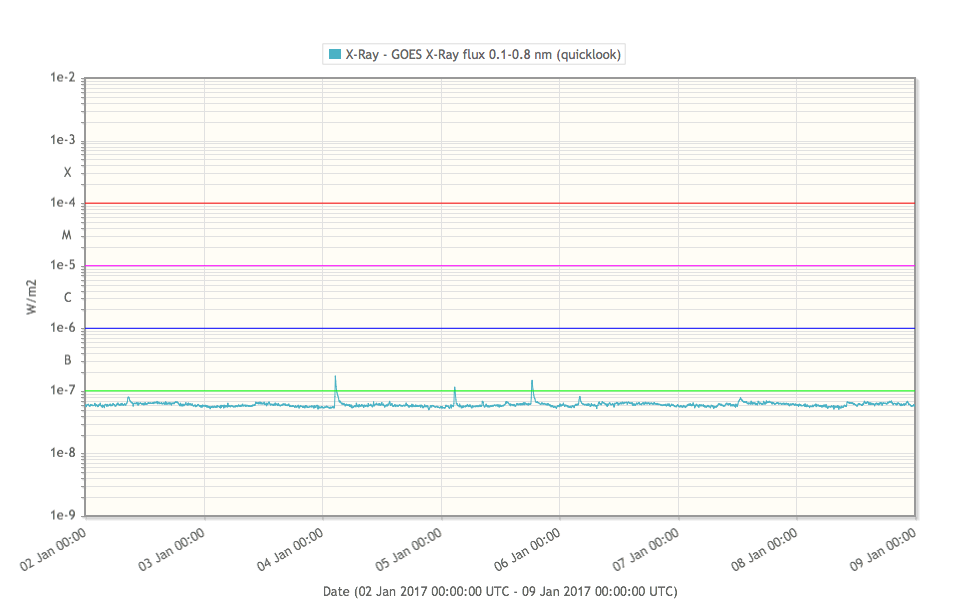
From the above graph with X-ray flux data from GOES, one can see that the X-ray flux was low, meaning that it stayed at background level. The graph below shows were this flux level is situated in the present and 2 earlier solar cycles (SC). It shows that we are heading towards solar minimum, but we are not there yet.
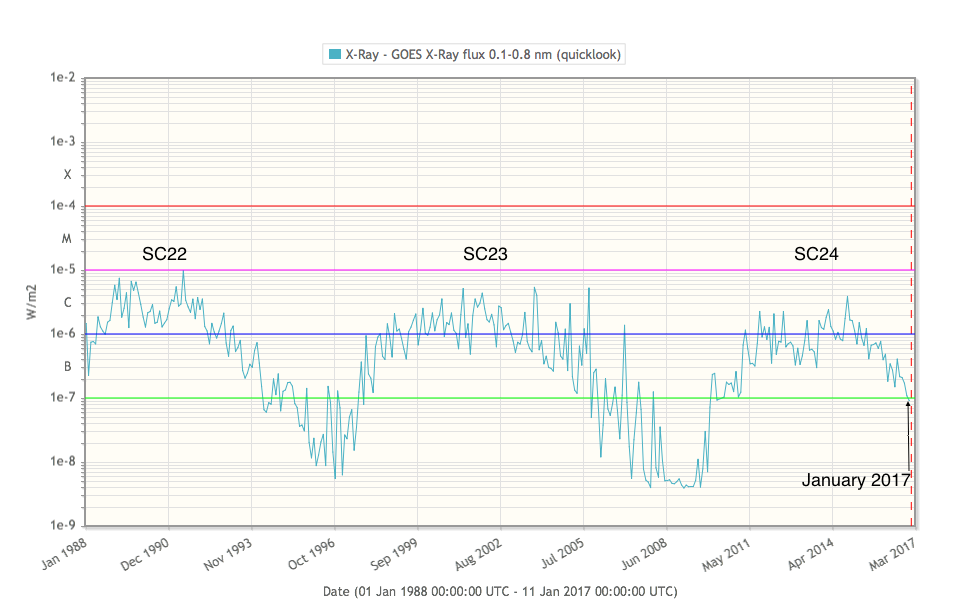
Only a small number of short lived sunspot groups were present at the start of the week producing at most a B1.8 flare.
No earth directed CMEs have been observed in coronagraph data.
Proton flux values were at background levels.
The International Sunspot Number
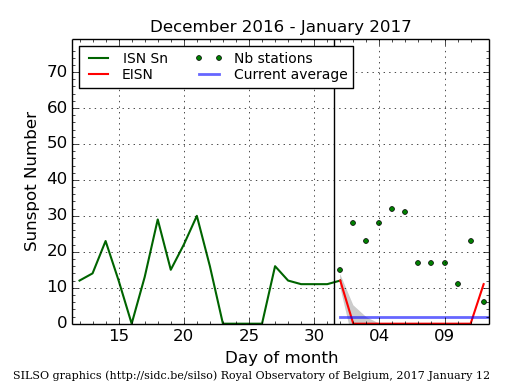
The daily Estimated International Sunspot Number (EISN, red curve with shaded error) derived by a simplified method from real-time data from the worldwide SILSO network. It extends the official Sunspot Number from the full processing of the preceding month (green line). The plot shows the last 30 days (about one solar rotation). The horizontal blue line shows the current monthly average, while the green dots give the number of stations included in the calculation of the EISN for each day.
Review of geomagnetic activity
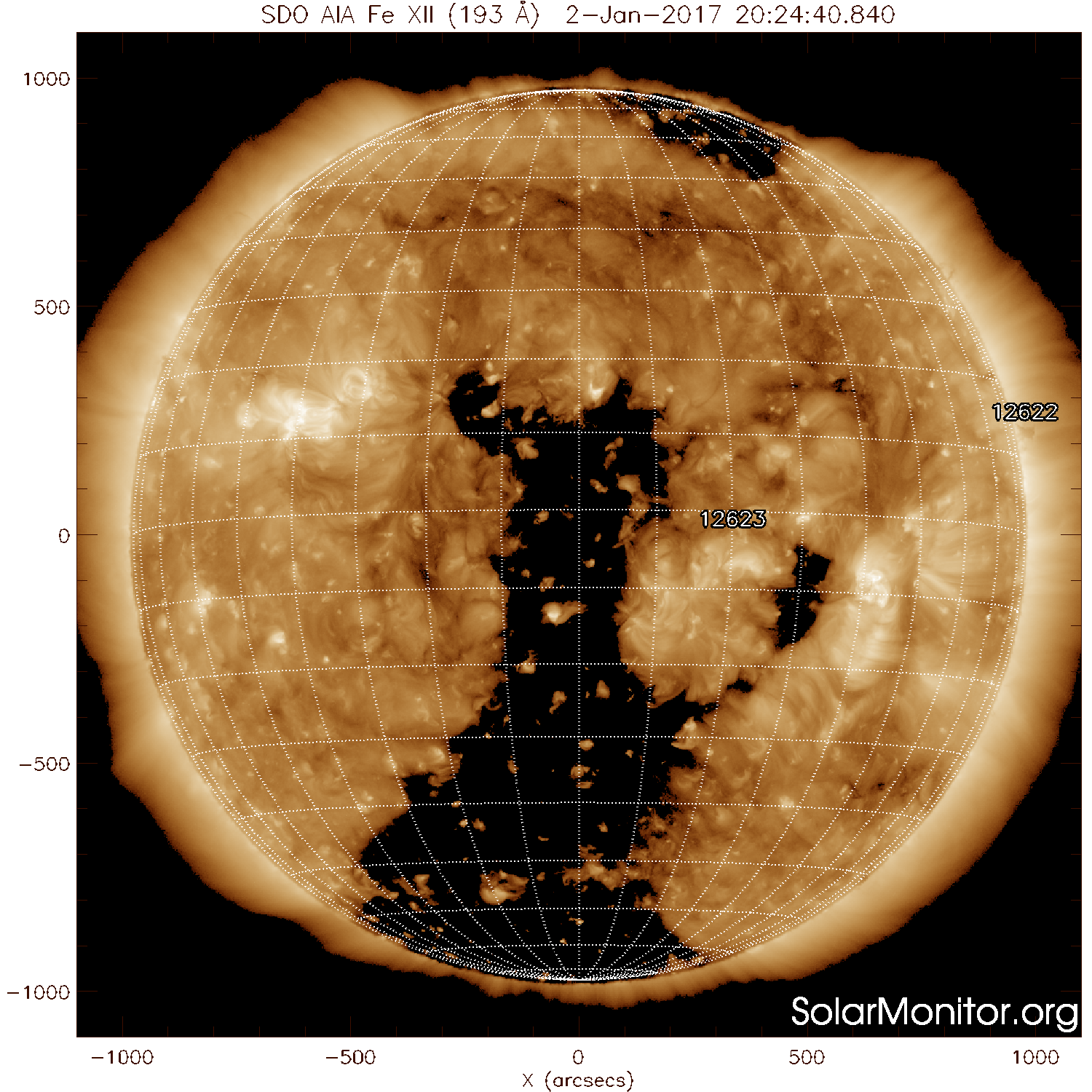
Solar wind was dominated by the arrival of the high speed stream from the trans equatorial extension of the negative polarity Southern polar coronal hole, visible in its full glory in the above SDO picture. It is the BIG dark area in the middle, you can't miss it.
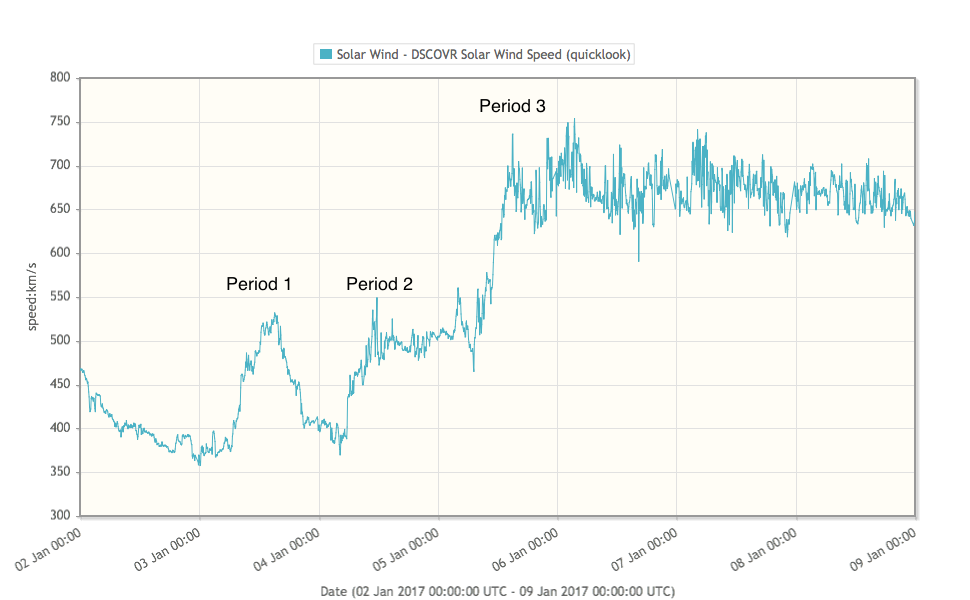
The bulk of the coronal hole extension is preceded by a smaller part which influenced solar wind speed on January 3. The speed reached a peak of 530 km/s before settling to a background below 400km/s (period 1). On January 4, a renewed increase of the solar wind to about 500km/s (period 2) was just another prelude to the main bulk of the high speed stream which set in around on January 5 (period 3). Speeds then reached values of over 700 km/s which persisted over the rest of the week (January 6, 7, 8).
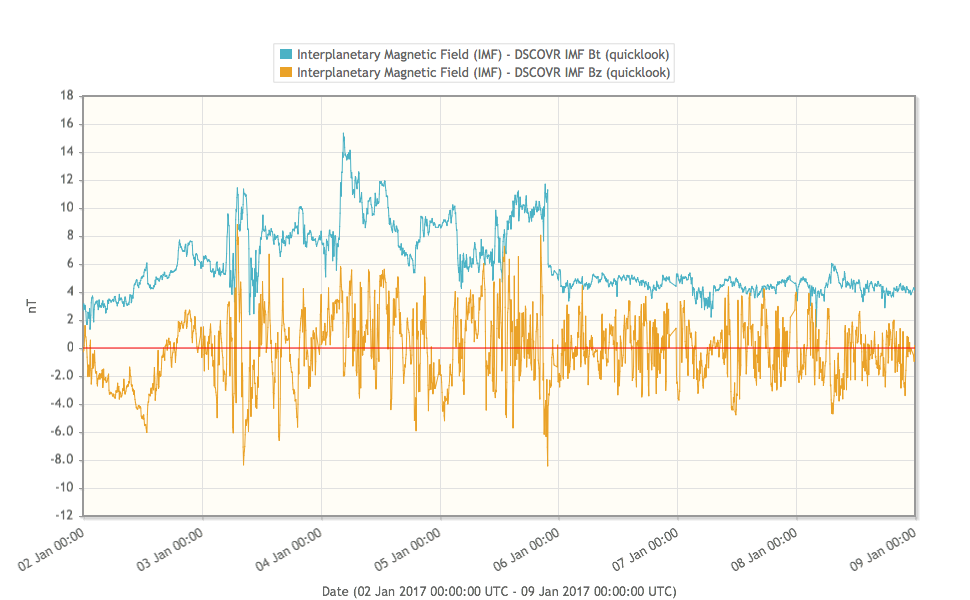
Total magnetic field enhancements were associated to the interaction regions at the high speed onsets and saw maxima of at most 15 nT. During the main part of the high speed stream influence (from January 6 onwards) total magnetic field was around the nominal 5nT regime. Bz was variable throughout the period.
With no periods of sustained negative Bz, enhancement of the geomagnetic conditions under the high speed stream influence, remained restricted to some periods of active conditions within otherwise quiet to unsettled conditions.
Review of ionospheric activity (2 Jan 2017 - 8 Jan 2017)
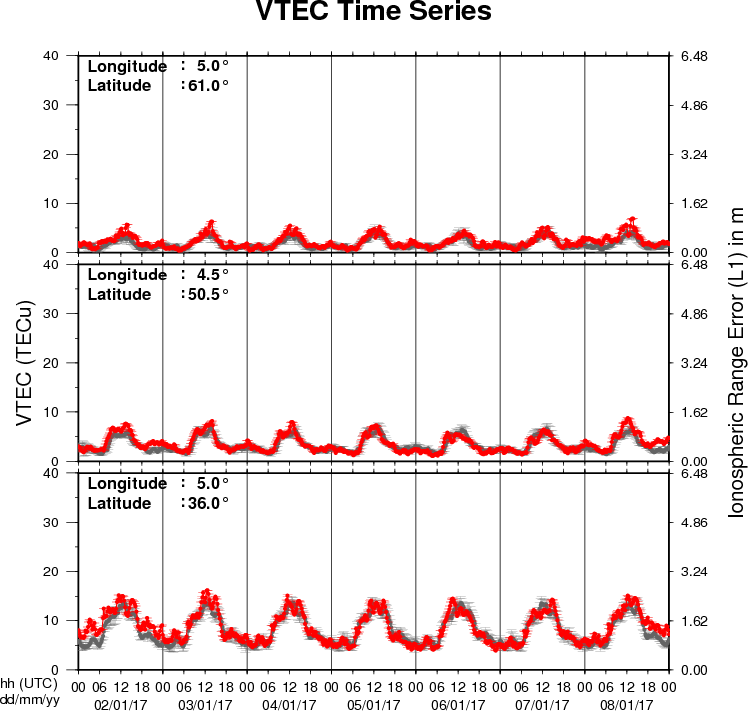
The figure shows the time evolution of the Vertical Total Electron Content (VTEC) (in red) during the last week at three locations:
a) in the northern part of Europe(N61°, 5°E)
b) above Brussels(N50.5°, 4.5°E)
c) in the southern part of Europe(N36°, 5°E)
This figure also shows (in grey) the normal ionospheric behaviour expected based on the median VTEC from the 15 previous days.
The VTEC is expressed in TECu (with TECu=10^16 electrons per square meter) and is directly related to the signal propagation delay due to the ionosphere (in figure: delay on GPS L1 frequency).
The Sun's radiation ionizes the Earth's upper atmosphere, the ionosphere, located from about 60km to 1000km above the Earth's surface.The ionization process in the ionosphere produces ions and free electrons. These electrons perturb the propagation of the GNSS (Global Navigation Satellite System) signals by inducing a so-called ionospheric delay.
See http://stce.be/newsletter/GNSS_final.pdf for some more explanations ; for detailed information, see http://gnss.be/ionosphere_tutorial.php
Future Events
For more details, see http://www.spaceweather.eu/en/event/future
4th SOLARNET Meeting: The Physics of the Sun from the Interior to the Outer Atmosphere, in Lanzarote (Spain)
Start : 2017-01-16 - End : 2017-01-20
The IV SOLARNET MEETING 'The physics of the Sun from the
interior to the outer atmosphere' will take place in Lanzarote
(Spain) from 16th to 20th of January 2017, organized by the
Instituto de AstrofÃsica de Canarias (IAC).
SOLARNET (High-resolution Solar Physics Network) is an EU-FP7
project coordinated by IAC with the aim of bringing together and
integrating the major European research infrastructures in the
field of high-resolution solar physics. SOLARNET involves all
pertinent European research institutions, infrastructures, and data
repositories. Networking activities, access to first-class
infrastructures and joint research and development activities are
being covered under SOLARNET to improve, in quantity and quality,
the service provided by this European community.
The purpose of this conference is to provide a coherent picture
of the Sun as a single physical system playing all the underlying
physical processes measured and observed in the solar atmosphere to
date.
Website:
http://www.iac.es/congreso/solarnet-4meeting/
Solar Orbiter Workshop 7: Exploring the solar environs in Granada, Spain
Start : 2017-04-03 - End : 2017-04-06
This event will be hosted by the Instituto de Astrofisica de
Andalucia - CSIC. Please mind that on April 7th the 20th SWT
meeting will take place at the same venue.
Website: Unkown
URSI General Assembly in Montreal, Canada
Start : 2017-08-19 - End : 2017-08-26
For the thirty-second time since the inception of URSI, Radio
Scientists from across the world will get together for the URSI
General Assembly and Scientific Symposium. This triennial gathering
will take place from 19th to 26th of August 2017, in Montreal,
Canada. This conference is a unique opportunity to learn about
recent advances in all fields of Radio Science, as covered by all
ten URSI Commissions.
Among the different sessions, please note:
* 'Radio Science for Space Weather'
Conveners: M. Messerotti, V. Pierrard
* 'Remote Sensing and Modeling of the Earth's Plasmasphere
and Plasmapause'
Conveners: A. M. Jorgensen, V. Pierrard, B. Heilig
The abstract deadline is 30 January 2017
Website: http://www.ursi2017.org
European Space Weather Week 14
Start : 2017-11-27 - End : 2017-12-01
The ESWW is the main annual event in the European Space Weather
calendar. It is the European forum for Space Weather as proven by
the high attendance to the past editions. The agenda will be
composed of plenary/parallel sessions, working meetings and
dedicated events for service end-users. The ESWW will again adopt
the central aim of bringing together the diverse groups in Europe
working on different aspects of Space Weather.
Website:
http://www.stce.be/esww14/
